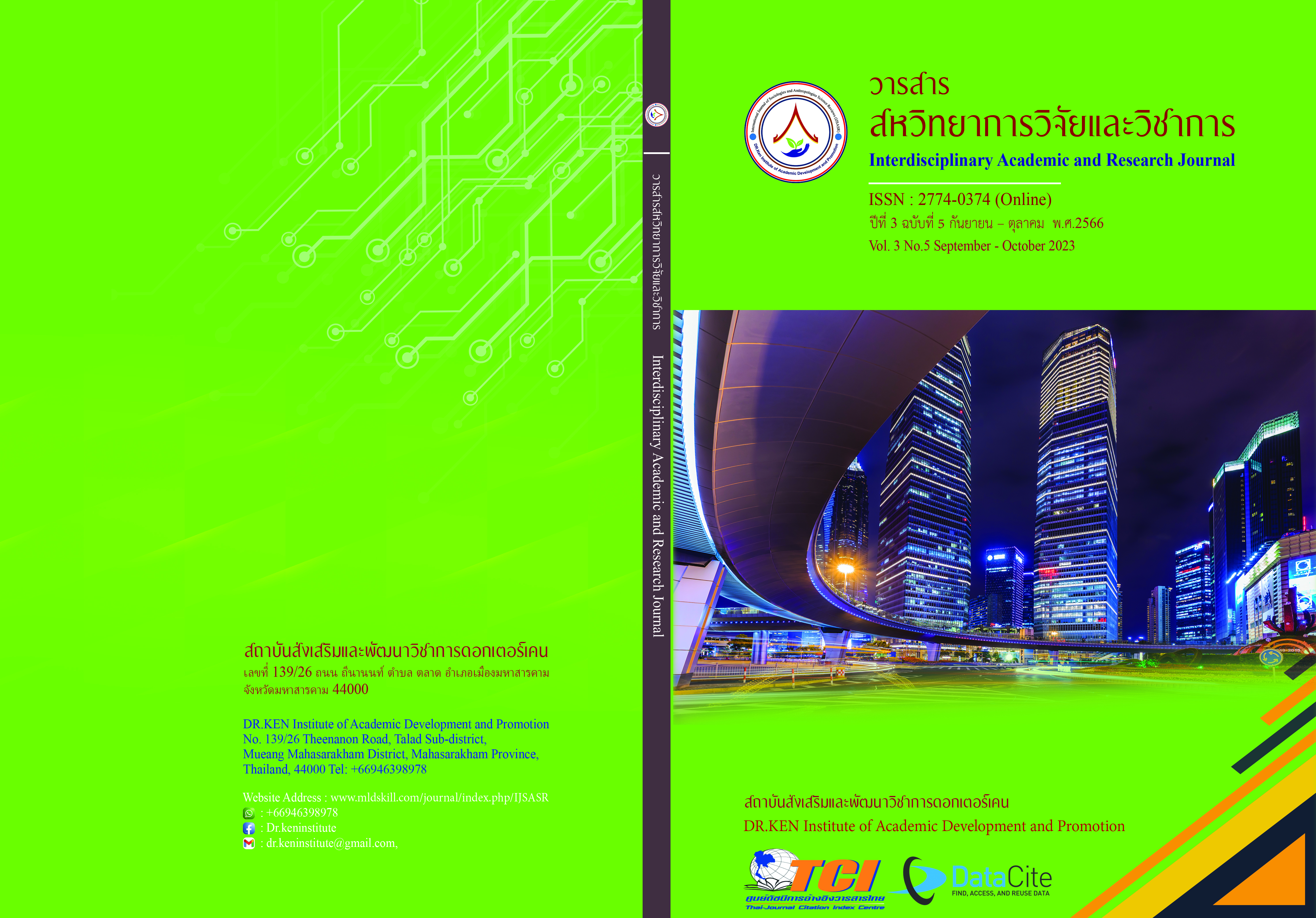Integrated Learning of STEM Education Concepts with Flipped Classroom to Improve Students' Chemistry Learning Achievement and Creative Skills in 11th Grade, Pakhampittayakom School
DOI:
https://doi.org/10.14456/iarj.2023.274Keywords:
STEM Education; , Flipped Classroom; , Creative Skills; , Learning AchievementAbstract
The concept of 21st-century skills is important for education. The development of advanced thinking skills, such as creative skills, is essential for the student's future. Developing students' creative skills through integrated learning methods, engaging students in learning and There is a teacher to support. This research aims to 1) develop an integrated learning of STEM Education with Flipped Classroom and 2) to evaluate the effects of integrated learning management based on STEM Education with Flipped Classroom on the development of learning achievement and creative skills in chemistry subjects of students in 11th Grade Pakham Pittayakom School. The students studying at Pakham Pittayakom School, Buriram Secondary Education Area Office. The sample size consisted of 27 students who were equally divided into experimental groups on the basis acquired by a specific selection method. The research instruments an integrated learning management plan based on STEM Education concepts with Flipped Classroom 9 hour. Collected Data, suitability assessment of the learning management plan, learning achievement test, Rubric scale Creativity Assessment. Statistics meaning, standard deviation, and t-value testing. The results of this study revealed that an integrated learning plan on STEM Education concepts with a Flipped Classroom is appropriate for improving students’ creative skills. Students’ average scores of post-tests (mean=20.63, SD=2.03) statistically significantly higher than pre-test (mean=17.07, SD=2.50), and .05 level, Creativity skills good level (mean=9.33, SD=1.37).
References
เกรียงศักดิ์ วิเชียรสร้าง. (2561). ผลของการจดัการเรียนรู้ตามแนวคิดสะเต็มศึกษา ที่มีต่อผลสมัฤทธิ์ ทางการเรียนวิชาเคมี ความสามารถในการแกปัญหาและความพงึพอใจต่อการ จัดการเรียนรู้ของนักเรียนชั้นชั้นมัธยมศึกษาปีที่ 6. วารสารศึกษาศาสตร์. มหาวิทยาลัยสงขลานครินทร์ วิทยาเขตปัตตานี.
ธนทร บับพาน. (2561). ผลการจัดกิจกรรมการเรียนรู้วิทยาศาสตร์ตามแนวคิดห้องเรียนกลับทางสำหรับนักเรียนชั้นมัธยมศึกษาปีที่ 2. วารสารครุพิบูล. มหาวิทยาลัยบูรพา
พรทิพย์ ศิริภัทราชัย. (2556). STEM Education กับการพัฒนาทักษะในศตวรรษที่ 21. วารสารนักบริหาร: 49-56.
พิมพ์ดาว นัดกล้าณรงฤทธิ์. (2562). การวิจัยเชิงปฏิบัติการเพื่อพัฒนาการคิดสร้างสรรค์และผลสัมฤทธิ์ทางการ เรียนด้วยรูปแบบห้องเรียนกลับด้าน. คณะครุศาสตร์. มหาวิทยาลัยราชภัฏมหาสารคาม
มหาวิทยาลัยราชภัฏวไลยอลงกรณ์. (2553). คู่มือการจัดระบบการเรียนการสอนที่ยึดผู้เรียนเป็นศูนย์กลางการเรียนรู้. โรงพิมพ์เทียนวัฒนา พริ้นท์ติ้ง
วธัญญู พิชญภูสิทธิ และ คณะ. (2563). การพัฒนากิจกรรมการเรียนรู้รายวิชาเคมี เรื่อง อัตราการเกิดปฏิกิริยาเคมีตามแนวทางสะเต็มศึกษาที่ส่งเสริมทักษะการเรียนรู้และนวัตกรรม สำหรับนักเรียนชั้นมัธยมศึกษาปีที่5. วารสารวิชาการและวิจัยสังคมศาสตร์. มหาวิทยาลัยราชภัฏนครสวรรค์.
วิสาขะ เยือกเย็น. (2561). ผลการจัดการเรียนรู้สะเต็มศึกษาของนักเรียนชั้นมัธยมศึกษาปีที่ 6 เรื่องไฟฟ้าเคมี. คณะวิทยาศาสตร์. มหาวิทยาลัยอุบลราชธานี
สถาบันส่งเสริมการสอนวิทยาศาสตร์และเทคโนโลยี. (2557). สะเต็มศึกษา(STEM Education). กรุงเทพฯ: สสวท.กระทรวงศึกษาธิการ.
อรวลัญช์ ผ่องบุรุษ. (2559). การเสริมสร้างความคิดสร้างสรรค์และผลสัมฤทธิ์ทางการเรียนของนักเรียนชั้น มัธยมศึกษาปีที่ 4 เรื่องสมบัติบางประการของของเหลวและสารละลายโดยใช้วิธีการสอนแบบ STEM ศึกษา. สำนักหอสมุด มหาวิทยาลัยเทคโนโลยีพระจอมเกล้าธนบุรี.
อัญธิชา แสนทวีสุข. (2563). ผลของการจัดการเรียนรู้ตามแนวคิดสะเต็มศึกษาที่มีต่อความคิดสร้างสรรค์ทาง วิทยาศาสตร์ของนักเรียนชั้นมัธยมศึกษาปี ที่ 4 ในรายวิชาชีววิทยา เรื่องโครงสร้างและหน้าที่ของเซลล์. สำนักหอสมุดมหาวิทยาลัยรังสิต.
Bergmann, J., & Sams, A. (2012). Flip your classroom: Reach every student in every class every day. Eugene, OR: International Society for Technology in Education.
Good, Carter V. (1973). Dictionary of Education (3rd ed). New York: McGraw-Hill.
Guilford, J.P. (1967). The Nature of Human Intelligence. New York: McGraw-Hill Book Co.
Mayasari, T., Kadarohman, A., Rusdiana, D., & Kaniawati, I. (2016). Exploration Of Student’s Creativity by Integrating STEM. Proceedings of International Seminar on Mathematics, Science, and Computer Science Education, p. 1-5.
Rodriguez, G., Diez, J., Perez, N., Banos, J., & Carrio, M. (2019). Flipped classroom: Fostering creative skills in undergraduate students of health sciences. ScienceDirect.
Wibawa, B., & Kardipah, S. (2018). The Flipped-Blended Model for STEM Education to Improve Student Performances. International Journal of Engineering & Technology, p. 1006-1009.
Downloads
Published
How to Cite
Issue
Section
License
Copyright (c) 2023 Boossadee Dusita, Angkana Chatkon

This work is licensed under a Creative Commons Attribution-NonCommercial-NoDerivatives 4.0 International License.
Copyright on any article in the Interdisciplinary Academic and Research Journal is retained by the author(s) under the under the Creative Commons Attribution-NonCommercial-NoDerivatives 4.0 International License. Permission to use text, content, images, etc. of publication. Any user to read, download, copy, distribute, print, search, or link to the full texts of articles, crawl them for indexing, pass them as data to software, or use them for any other lawful purpose. But do not use it for commercial use or with the intent to benefit any business.
















.png)


